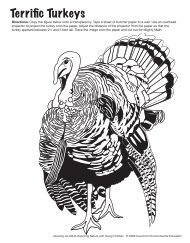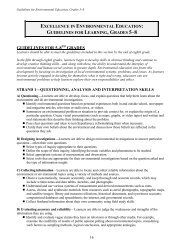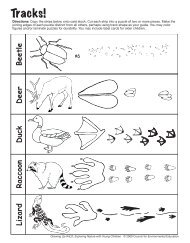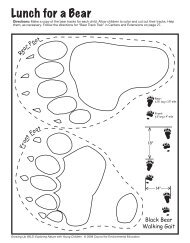Project WILD Aquatic K-12 Curriculum and Activity Guide
Project WILD Aquatic K-12 Curriculum and Activity Guide
Project WILD Aquatic K-12 Curriculum and Activity Guide
- No tags were found...
You also want an ePaper? Increase the reach of your titles
YUMPU automatically turns print PDFs into web optimized ePapers that Google loves.
<strong>Project</strong> <strong>WILD</strong> <strong>Aquatic</strong> K–<strong>12</strong> <strong>Curriculum</strong><br />
<strong>and</strong> <strong>Activity</strong> <strong>Guide</strong> Student Pages
........................................................................................................<br />
Principal Sponsors<br />
<strong>Project</strong> <strong>WILD</strong> is administered by the Council for<br />
Environmental Education <strong>and</strong> is cosponsored by the<br />
Western Association of Fish <strong>and</strong> Wildlife Agencies.<br />
The views <strong>and</strong> conclusions contained in this document<br />
are those of the authors <strong>and</strong> should not be interpreted<br />
as representing the opinions or policies of the U.S.<br />
Government. Mention of trade names or commercial<br />
products does not constitute their endorsement by<br />
the U.S. Government.<br />
Cover photos of large-mouth bass <strong>and</strong> swordfish courtesy<br />
of Bass Pro Shops.<br />
Awards <strong>and</strong> Recognition<br />
<strong>Project</strong> <strong>WILD</strong>, its sponsors, <strong>and</strong> many of its participants—<br />
including students <strong>and</strong> educators—have received a variety<br />
of awards <strong>and</strong> recognition. <strong>Project</strong> <strong>WILD</strong> was honored at<br />
the White House in 1991 as one of the first recipients of<br />
a Gold Medal for Education <strong>and</strong> Communications in the<br />
President’s Environment <strong>and</strong> Conservation Challenge<br />
Award program. This award was bestowed “for excellence<br />
in developing innovative solutions to the nation’s environmental<br />
challenges.” <strong>Project</strong> <strong>WILD</strong> has also received the<br />
Conservation Education Award from The Wildlife Society.<br />
These materials have been endorsed by the National<br />
Council for the Social Studies <strong>and</strong> are consistent with<br />
recommendations of the National Science Teachers<br />
Association.<br />
........................................................................................................<br />
These materials have been developed through a cooperative agreement with the U.S. Fish <strong>and</strong> Wildlife Service. By this agreement,<br />
these materials can be made available to state fish <strong>and</strong> wildlife agencies through the U.S. Fish <strong>and</strong> Wildlife Service.<br />
Funding for the development of these materials has been provided with support from monies made possible through the<br />
Wallop-Breaux Amendment to the Sport Fish Restoration Act. This federal legislation provides support for aquatic resources<br />
education to increase public underst<strong>and</strong>ing of, <strong>and</strong> responsibility toward, the nation’s water resources <strong>and</strong> aquatic life forms.<br />
<strong>Project</strong> <strong>WILD</strong><br />
5555 Morningside Drive, Suite 2<strong>12</strong><br />
Houston, TX 77005<br />
Phone: (713) 520-1936 Fax: (713) 520-8008<br />
E-mail: info@projectwild.org<br />
Web: www.projectwild.org<br />
5555 Morningside Drive, Suite 2<strong>12</strong><br />
Houston, TX 77005<br />
Phone: (713) 520-1936 Fax: (713) 520-8008<br />
E-mail: info@c-e-e.org<br />
Web: www.councilforee.org<br />
........................................................................................................<br />
© Copyright 2002, 2001, 2000, 1992, 1985 <strong>and</strong> 1983 by the Council for Environmental Education.<br />
All rights reserved.<br />
This volume contains student resource pages, which may be reproduced without permission for educational<br />
use in conjunction with <strong>Project</strong> <strong>WILD</strong> activities contained within the <strong>Project</strong> <strong>WILD</strong> <strong>Aquatic</strong> K-<strong>12</strong> <strong>Curriculum</strong><br />
& <strong>Activity</strong> <strong>Guide</strong>. For all other uses, please contact the Council for Environmental Education.
Student Pages Table of Contents<br />
Section One:<br />
Ecological Knowledge<br />
Wildlife Populations (WP)<br />
Are You Me .......................................................1<br />
Whale of a Tail ...................................................5<br />
Migration Headache............................................9<br />
Habitats, Ecosystems, <strong>and</strong> Niches (HN)<br />
Where Does Water Run ...................................10<br />
Water Canaries.................................................11<br />
Interdependence (ID)<br />
Marsh Munchers...............................................14<br />
Hooks <strong>and</strong> Ladders ...........................................16<br />
Micro Odyssey ..................................................18<br />
Blue-Ribbon Niche ............................................19<br />
Changes <strong>and</strong> Adaptations (CA)<br />
Fashion a Fish...................................................20<br />
Sockeye Scents ...................................................22<br />
Eat <strong>and</strong> Glow ..................................................23<br />
Section Two:<br />
Social <strong>and</strong> Political Knowledge<br />
Section Three:<br />
Sustaining Fish <strong>and</strong> Wildlife Resources<br />
Attitudes <strong>and</strong> Awareness (AA)<br />
Water Wings .....................................................33<br />
Puddle Wonders! ...............................................34<br />
How Wet Is Our Planet ...................................39<br />
Human Impacts (HI)<br />
Plastic Jellyfish ..................................................40<br />
Watershed .........................................................41<br />
Alice in Waterl<strong>and</strong> ............................................42<br />
Issues <strong>and</strong> Trends (IT)<br />
Turtle Hurdles ...................................................44<br />
Where Have All the Salmon Gone ...................46<br />
To Dam or Not to Dam.....................................48<br />
Wildlife Management (WM)<br />
Silt: A Dirty Word.............................................49<br />
Dam Design......................................................50<br />
Responsible Action <strong>and</strong> Service (RA)<br />
Kelp Help..........................................................51<br />
Dragonfly Pond .................................................53<br />
Economic, Commercial, <strong>and</strong><br />
Recreational Considerations (EC)<br />
Net Gain, Net Effect .........................................25<br />
Political <strong>and</strong> Legislative Frameworks (PL)<br />
Sea Turtles International ...................................26<br />
....................................................................................................<br />
© Council for Environmental Education 2004 ii
Alphabetical Listing<br />
Alice in Waterl<strong>and</strong> .....................................................................................................................................42<br />
Are You Me ................................................................................................................................................1<br />
Blue-Ribbon Niche ....................................................................................................................................19<br />
Dam Design...............................................................................................................................................50<br />
Dragonfly Pond ..........................................................................................................................................53<br />
Eat <strong>and</strong> Glow ............................................................................................................................................23<br />
Fashion a Fish.............................................................................................................................................20<br />
Hooks <strong>and</strong> Ladders ....................................................................................................................................16<br />
How Wet Is Our Planet............................................................................................................................39<br />
Kelp Help ..................................................................................................................................................51<br />
Marsh Munchers ........................................................................................................................................14<br />
Micro Odyssey...........................................................................................................................................18<br />
Migration Headache.....................................................................................................................................9<br />
Net Gain, Net Effect .................................................................................................................................25<br />
Plastic Jellyfish ...........................................................................................................................................40<br />
Puddle Wonders!........................................................................................................................................34<br />
Sea Turtles International ...........................................................................................................................26<br />
Silt: A Dirty Word......................................................................................................................................49<br />
Sockeye Scents...........................................................................................................................................22<br />
To Dam or Not to Dam.............................................................................................................................48<br />
Turtle Hurdles............................................................................................................................................44<br />
Water Canaries ..........................................................................................................................................11<br />
Water Wings ..............................................................................................................................................33<br />
Watershed ..................................................................................................................................................41<br />
Whale of a Tail.............................................................................................................................................5<br />
Where Does Water Run ...........................................................................................................................10<br />
Where Have All the Salmon Gone ..........................................................................................................46<br />
iii<br />
....................................................................................................<br />
<strong>Project</strong> <strong>WILD</strong> <strong>Aquatic</strong> K–<strong>12</strong> <strong>Curriculum</strong> <strong>and</strong> <strong>Activity</strong> <strong>Guide</strong> Student Pages
E c o l o g i c a l K n o w l e d g e<br />
........................................................................................................<br />
A r e Y o u M e <br />
Osprey<br />
Osprey Hatchlings<br />
Stonefly<br />
Stonefly Nymph<br />
Dragonfly<br />
Dragonfly Nymph<br />
Caddisfly<br />
Caddisfly Larvae<br />
Whirling Beetle<br />
Whirling Larva<br />
....................................................................................................<br />
© Council for Environmental Education 2004 1
E c o l o g i c a l K n o w l e d g e<br />
........................................................................................................<br />
A r e Y o u M e <br />
Frog<br />
Tadpoles<br />
Duck<br />
Ducklings<br />
Butterfly<br />
Butterfly Larvae<br />
Pelican<br />
Pelican Nest <strong>and</strong> Eggs<br />
Mayfly<br />
Mayfly Nymph<br />
2<br />
....................................................................................................<br />
<strong>Project</strong> <strong>WILD</strong> <strong>Aquatic</strong> K–<strong>12</strong> <strong>Curriculum</strong> <strong>and</strong> <strong>Activity</strong> <strong>Guide</strong> Student Pages
E c o l o g i c a l K n o w l e d g e<br />
........................................................................................................<br />
A r e Y o u M e <br />
Skate<br />
Skate Egg Cases<br />
Manatee<br />
Young Manatee<br />
Cranefly<br />
Cranefly Larva<br />
Sea Otter<br />
Young Sea Otters<br />
Sea Turtle<br />
Sea Turtle Eggs<br />
....................................................................................................<br />
© Council for Environmental Education 2004 3
E c o l o g i c a l K n o w l e d g e<br />
........................................................................................................<br />
A r e Y o u M e <br />
Adult Beaver<br />
Young Beavers<br />
Mosquito<br />
Mosquito Larva<br />
Porpoise<br />
Young Porpoise<br />
Black Fly<br />
Black Fly Larva<br />
Alligator<br />
Alligator Hatchlings<br />
4<br />
....................................................................................................<br />
<strong>Project</strong> <strong>WILD</strong> <strong>Aquatic</strong> K–<strong>12</strong> <strong>Curriculum</strong> <strong>and</strong> <strong>Activity</strong> <strong>Guide</strong> Student Pages
E c o l o g i c a l K n o w l e d g e<br />
........................................................................................................<br />
W h a l e o f a T a i l<br />
2 3 5<br />
2 3<br />
5<br />
Diagram A<br />
....................................................................................................<br />
© Council for Environmental Education 2004 5
E c o l o g i c a l K n o w l e d g e<br />
........................................................................................................<br />
W h a l e o f a T a i l<br />
Diagram B<br />
6<br />
....................................................................................................<br />
<strong>Project</strong> <strong>WILD</strong> <strong>Aquatic</strong> K–<strong>12</strong> <strong>Curriculum</strong> <strong>and</strong> <strong>Activity</strong> <strong>Guide</strong> Student Pages
E c o l o g i c a l K n o w l e d g e<br />
........................................................................................................<br />
W h a l e o f a T a i l<br />
List of Materials<br />
1. Black plastic, 4 mil, 24 feet (7.2 m) by 100 feet (30 m)<br />
2. Clear/White plastic, 4 mil, 16 feet by 100 feet (4.8 m by 30 m)<br />
3. Clear 2 inch (5 cm) wide plastic tape—20 rolls<br />
Tools Needed<br />
1. Tape measures, 100 feet (30 m) <strong>and</strong> 26 feet (8 m)<br />
2. Scissors to cut the plastic <strong>and</strong> tape<br />
3. High-speed fan<br />
Steps<br />
1. Lay plastic on 10-foot (1 m) grid.<br />
2. Cut out all parts; cut out some of the flippers or tail flukes<br />
from the cutout sections of the whale body.<br />
3. Tape together the flippers <strong>and</strong> tail flukes (remember the<br />
right <strong>and</strong> left sides for both), <strong>and</strong> tape together the top<br />
dorsal fin. Do not tape the body (straight side) connection.<br />
4. After taping the “fins,” turn inside out, placing the tape<br />
seam inside.<br />
5. Tape together the cutout sections of the whale’s top<br />
section as indicated on the plan.<br />
6. Tape together the cutout sections of the whale’s bottom<br />
section as indicated on the plan.<br />
7. Place the tail flukes <strong>and</strong> flippers on the bottom section<br />
of the whale at their locations.<br />
8. Start taping the top section to the bottom section, using<br />
the tail flukes as side walls where they connect to the<br />
body; start at the tail section on each side <strong>and</strong> work<br />
toward the mouth area.<br />
9. Do not tape the end of the tail section together.<br />
10. Mouth area—the clear/white plastic will have to be<br />
pleated to meet the side area taping; start in the center of<br />
the mouth <strong>and</strong> work out the sides—about 2 inches (5 m)<br />
for each pleat.<br />
11. Once the whale is fully taped, place the fan in the tail<br />
opening <strong>and</strong> inflate the whale. One person will go into the<br />
whale to the nose section <strong>and</strong> pull the nose section out<br />
through the tail opening, inverting the seams <strong>and</strong> letting<br />
the flippers <strong>and</strong> tail flukes to the outside.<br />
<strong>12</strong>. Mount the top dorsal fin on the black top section in the<br />
center of the tail section about 58 feet (17.4 m) from the<br />
front of the whale.<br />
13. Place the-9 inch (22 cm)<br />
eye drawings on the<br />
top section, just in front<br />
9” (22 cm)<br />
of the flippers.<br />
14. Inflate the model with the high-speed fan; step back <strong>and</strong><br />
give it room.<br />
........................................................................................................<br />
Tail Flukes<br />
2 black <strong>and</strong> 2 clear/white pieces<br />
(Will create right <strong>and</strong> left tail sections)<br />
6’ (1.8 m)<br />
Pattern for Life-Size Whale<br />
Top Dorsal Fin<br />
2 black pieces<br />
3’ (1 m)<br />
Flippers<br />
2 black <strong>and</strong> clear/white pieces<br />
(Will create right <strong>and</strong> left flipper sections)<br />
5’ (1.5 m)<br />
(This side attaches<br />
to body of whale)<br />
6’ (1.8 m)<br />
<strong>12</strong>’ (3.6 m)<br />
16’ (4.8 m)<br />
....................................................................................................<br />
© Council for Environmental Education 2004 7
E c o l o g i c a l K n o w l e d g e<br />
........................................................................................................<br />
W h a l e o f a T a i l<br />
24’ (7.2 m)<br />
16’ (4.8 m)<br />
10’ (3 m)<br />
10’ (3 m)<br />
Top Section<br />
24’ x 100’ (7.2 m x 30 m) 4 mil black plastic<br />
20’ (4.5 m) 28’ (8.4 m) 33’ (9.9 m) 40’ (<strong>12</strong> m) 50’ (15 m) 60’ (18 m)<br />
70’ (21 m)<br />
7’<br />
(2.1 m)<br />
5’<br />
(1.5 m)<br />
4’<br />
(1.2 m)<br />
4’<br />
(1.2 m)<br />
<strong>12</strong>’<br />
(3.6 m)<br />
<strong>12</strong>’<br />
(3.6 m)<br />
16’<br />
(4.8 m)<br />
7’<br />
(2.1 m)<br />
5’<br />
(1.5 m)<br />
4’<br />
(1.2 m)<br />
4’<br />
(1.2 m)<br />
7’<br />
(2.1 m)<br />
5’<br />
(1.5 m)<br />
4’<br />
(1.2 m)<br />
4’<br />
(1.2 m)<br />
8’<br />
(2.4 m)<br />
6’ (1.8 m)<br />
7’<br />
(2.1 m)<br />
5’<br />
(1.5 m)<br />
4’<br />
(1.2 m)<br />
6’ (1.8 m)<br />
4’<br />
(1.2 m)<br />
15’ (4.5 m) 20’ (6 m) 30’ (9.9 m) 40’ (<strong>12</strong> m) 50’ (15 m) 60’ (18 m) 70‘ (21 m)<br />
Bottom Section<br />
16’ x 100’ (4.8 m x 30 m) 4 mil clear/white plastic<br />
4’<br />
(1.2 m)<br />
8’<br />
(2.4 m)<br />
4’<br />
(1.2 m)<br />
5’<br />
(1.5 m)<br />
2’<br />
(0.6 m)<br />
10’<br />
(3 m)<br />
2’<br />
(0.6 m)<br />
5’<br />
(1.5 m)<br />
8<br />
....................................................................................................<br />
<strong>Project</strong> <strong>WILD</strong> <strong>Aquatic</strong> K–<strong>12</strong> <strong>Curriculum</strong> <strong>and</strong> <strong>Activity</strong> <strong>Guide</strong> Student Pages
E c o l o g i c a l K n o w l e d g e<br />
........................................................................................................<br />
M i g r a t i o n H e a d a c h e<br />
....................................................................................................<br />
© Council for Environmental Education 2004 9
E c o l o g i c a l K n o w l e d g e<br />
........................................................................................................<br />
W h e r e D o e s W a t e r R u n <br />
The Water Cycle<br />
Diagram A<br />
10 ....................................................................................................<br />
<strong>Project</strong> <strong>WILD</strong> <strong>Aquatic</strong> K–<strong>12</strong> <strong>Curriculum</strong> <strong>and</strong> <strong>Activity</strong> <strong>Guide</strong> Student Pages
E c o l o g i c a l K n o w l e d g e<br />
........................................................................................................<br />
W a t e r C a n a r i e s<br />
....................................................................................................<br />
© Council for Environmental Education 2004 11
E c o l o g i c a l K n o w l e d g e<br />
........................................................................................................<br />
W a t e r C a n a r i e s<br />
pH Ranges That Support <strong>Aquatic</strong> Life<br />
Most Acidic Neutral Most Basic<br />
1 2 3 4 5 6 7 8 9 10 11 <strong>12</strong> 13 14<br />
Bacteria<br />
1.0 13.0<br />
Plants (algae, rooted, etc.) 6.5 13.0<br />
Carps, suckers, catfish, some insects 6.0 8.5<br />
Bass, crappie 6.0 8.5<br />
Snails, clams, mussels 6.5 9.0<br />
Largest variety of animals 6.0 8.5<br />
(trout, mayfly, stonefly, caddisfly)<br />
Temperature Ranges (Approximate) Required for Certain Organisms<br />
Temperature<br />
Greater than 68 °F (20 °C) = Warm water<br />
Much plant life, many fish diseases<br />
Most bass, crappie, bluegill, carp, catfish, caddisfly,<br />
dragonfly, mayfly, mussels.<br />
55 – 68 °F (<strong>12</strong>.8 – 20 °C) = Cool water Plant life, some fish diseases<br />
Salmon, trout, stonefly, mayfly, caddisfly, water beetles, smallmouth<br />
<strong>and</strong> rock bass, various minnows <strong>and</strong> darters, mussels<br />
Less than 55 °F (<strong>12</strong>.8 °C) = Cold water<br />
Trout, caddisfly, stonefly, mayfly, various minnows,<br />
darters, sculpins<br />
Dissolved Oxygen (DO) Requirements for Native Fish <strong>and</strong><br />
Other <strong>Aquatic</strong> Life (DO in parts per million [ppm])<br />
(Below 68 °F)<br />
Cold-water organisms including salmon <strong>and</strong> trout<br />
(Above 68 °F)<br />
Warm-water organisms including fish such as<br />
bass, crappie, catfish, <strong>and</strong> carp<br />
6 ppm 5 ppm<br />
<strong>12</strong> ....................................................................................................<br />
<strong>Project</strong> <strong>WILD</strong> <strong>Aquatic</strong> K–<strong>12</strong> <strong>Curriculum</strong> <strong>and</strong> <strong>Activity</strong> <strong>Guide</strong> Student Pages
E c o l o g i c a l K n o w l e d g e<br />
........................................................................................................<br />
W a t e r C a n a r i e s<br />
Student Worksheet I<br />
Where Organism Was Found Sketch of Organism Number Found<br />
Student Worksheet II<br />
Observations<br />
Predictions<br />
Water Temperature __________<br />
Air Temperature _____________<br />
pH _________________________<br />
Dissolved O 2<br />
________________<br />
....................................................................................................<br />
© Council for Environmental Education 2004 13
E c o l o g i c a l K n o w l e d g e<br />
........................................................................................................<br />
M a r s h M u n c h e r s<br />
Diagram A<br />
14 ....................................................................................................<br />
<strong>Project</strong> <strong>WILD</strong> <strong>Aquatic</strong> K–<strong>12</strong> <strong>Curriculum</strong> <strong>and</strong> <strong>Activity</strong> <strong>Guide</strong> Student Pages
E c o l o g i c a l K n o w l e d g e<br />
........................................................................................................<br />
M a r s h M u n c h e r s<br />
Predators<br />
Master for Marsh Muncher<br />
Person Fishing: Student<br />
walks forward casting line,<br />
<strong>and</strong> tags prey by grasping<br />
on the shoulder.<br />
Blue Crab: Student walks<br />
sideways, waving arms like<br />
claws <strong>and</strong> grasps prey.<br />
Raccoon: Student walks<br />
forward washing h<strong>and</strong>s<br />
<strong>and</strong> grasps prey.<br />
Red Drum Fish: Student<br />
walks with h<strong>and</strong>s held<br />
forward like a mouth, <strong>and</strong><br />
grasps prey.<br />
Egret: Student struts with<br />
h<strong>and</strong>s on hips, so elbows are<br />
like wings. Nearing prey, arms<br />
become a beak to grasp prey.<br />
Detritus-Eaters<br />
Juvenile Fish: Gulps down detritus<br />
particles in the water or on<br />
the bottom. (Student puckers lips<br />
<strong>and</strong> makes sucking noises while<br />
feeding.)<br />
Juvenile Fish: Gulps down detritus<br />
particles in the water or on<br />
the bottom. (Student puckers lips<br />
<strong>and</strong> makes sucking noises while<br />
feeding.)<br />
Juvenile Fish: Gulps down detritus<br />
particles in the water or on<br />
the bottom. (Student puckers lips<br />
<strong>and</strong> makes sucking noises while<br />
feeding.)<br />
Juvenile Fish: Gulps down detritus<br />
particles in the water or on<br />
the bottom. (Student puckers lips<br />
<strong>and</strong> makes sucking noises while<br />
feeding.)<br />
Shrimp: Stirs up mud <strong>and</strong> detritus<br />
with walking legs that<br />
lift particles to mouth. (Student<br />
makes stirring motions with<br />
both arms.)<br />
Shrimp: Stirs up mud <strong>and</strong> detritus<br />
with walking legs that<br />
lift particles to mouth. (Student<br />
makes stirring motions with<br />
both arms.)<br />
Shrimp: Stirs up mud <strong>and</strong> detritus<br />
with walking legs that<br />
lift particles to mouth. (Student<br />
makes stirring motions with<br />
both arms.)<br />
Shrimp: Stirs up mud <strong>and</strong> detritus<br />
with walking legs that<br />
lift particles to mouth. (Student<br />
makes stirring motions with<br />
both arms.)<br />
Snail: Licks up detritus with<br />
specialized tongue called radula.<br />
(Student displays licking motion,<br />
using one h<strong>and</strong> as the radula.)<br />
Snail: Licks up detritus with<br />
specialized tongue called radula.<br />
(Student displays licking motion,<br />
using one h<strong>and</strong> as the radula.)<br />
Snail: Licks up detritus with<br />
specialized tongue called radula.<br />
(Student displays licking motion,<br />
using one h<strong>and</strong> as the radula.)<br />
Snail: Licks up detritus with<br />
specialized tongue called radula.<br />
(Student displays licking motion,<br />
using one h<strong>and</strong> as the radula.)<br />
Oyster: Filters detritus from<br />
water using gills. (Student waves<br />
arms back <strong>and</strong> forth in air.)<br />
Oyster: Filters detritus from<br />
water using gills. (Student waves<br />
arms back <strong>and</strong> forth in air.)<br />
Oyster: Filters detritus from<br />
water using gills. (Student waves<br />
arms back <strong>and</strong> forth in air.)<br />
Oyster: Filters detritus from<br />
water using gills. (Student waves<br />
arms back <strong>and</strong> forth in air.)<br />
Fiddler Crab: Picks detritus from<br />
s<strong>and</strong> with one or two claws.<br />
(Students pick objects from floor<br />
with thumbs <strong>and</strong> fingers acting<br />
as claws.)<br />
Fiddler Crab: Picks detritus from<br />
s<strong>and</strong> with one or two claws.<br />
(Students pick objects from floor<br />
with thumbs <strong>and</strong> fingers acting<br />
as claws.)<br />
Fiddler Crab: Picks detritus from<br />
s<strong>and</strong> with one or two claws.<br />
(Students pick objects from floor<br />
with thumbs <strong>and</strong> fingers acting<br />
as claws.)<br />
Fiddler Crab: Picks detritus from<br />
s<strong>and</strong> with one or two claws.<br />
(Students pick objects from floor<br />
with thumbs <strong>and</strong> fingers acting<br />
as claws.)<br />
....................................................................................................<br />
© Council for Environmental Education 2004 15
E c o l o g i c a l K n o w l e d g e<br />
........................................................................................................<br />
H o o k s a n d L a d d e r s<br />
Life Cycle of the Pacific Salmon<br />
Female<br />
Smolts<br />
Fry<br />
Alevin<br />
Matures in open ocean<br />
Eggs<br />
Male<br />
Returns to stream where hatched<br />
16 ....................................................................................................<br />
<strong>Project</strong> <strong>WILD</strong> <strong>Aquatic</strong> K–<strong>12</strong> <strong>Curriculum</strong> <strong>and</strong> <strong>Activity</strong> <strong>Guide</strong> Student Pages
E c o l o g i c a l K n o w l e d g e<br />
........................................................................................................<br />
H o o k s a n d L a d d e r s<br />
Diagram A<br />
....................................................................................................<br />
© Council for Environmental Education 2004 17
E c o l o g i c a l K n o w l e d g e<br />
........................................................................................................<br />
M i c r o O d y s s e y<br />
Diagram A<br />
18 ....................................................................................................<br />
<strong>Project</strong> <strong>WILD</strong> <strong>Aquatic</strong> K–<strong>12</strong> <strong>Curriculum</strong> <strong>and</strong> <strong>Activity</strong> <strong>Guide</strong> Student Pages
E c o l o g i c a l K n o w l e d g e<br />
........................................................................................................<br />
B l u e - R i b b o n N i c h e<br />
Diagram A<br />
....................................................................................................<br />
© Council for Environmental Education 2004 19
E c o l o g i c a l K n o w l e d g e<br />
........................................................................................................<br />
F a s h i o n a F i s h<br />
Eggs Deposited in Nests (Blue Gill)<br />
Dark Upper Side (Catfish)<br />
Eggs Deposited on Vegetation (Yellow Perch)<br />
Mottled (Crappie)<br />
Eggs Deposited on Bottom (Trout)<br />
Vertical Stripes (Croaker)<br />
Free Floating Eggs (Striped Bass)<br />
Coloration<br />
Reproduction<br />
Coloration<br />
Reproduction<br />
Reproduction<br />
Reproduction<br />
Coloration<br />
Reproduction<br />
Light Colored Belly (Albacore)<br />
Coloration<br />
Coloration<br />
Horizontal Stripes (Yellow Bass)<br />
Live Birth (Gambusia)<br />
20 ....................................................................................................<br />
<strong>Project</strong> <strong>WILD</strong> <strong>Aquatic</strong> K–<strong>12</strong> <strong>Curriculum</strong> <strong>and</strong> <strong>Activity</strong> <strong>Guide</strong> Student Pages
E c o l o g i c a l K n o w l e d g e<br />
........................................................................................................<br />
F a s h i o n a F i s h<br />
Flat Bellied (Catfish)<br />
Sucker Shaped Jaw (Sucker)<br />
Shape<br />
Mouth/Feeding<br />
Shape<br />
Mouth/Feeding<br />
Shape<br />
Mouth/Feeding<br />
Shape<br />
Mouth/Feeding<br />
Shape<br />
Mouth/Feeding<br />
Torpedo Shape (Wahoo)<br />
Extremely Large Jaws (Grouper)<br />
Elongated Lower Jaw (Barracuda)<br />
Horizontal Disc (Halibut)<br />
Vertical Disc (Butterfish)<br />
Duckbill Jaws (Muskellunge)<br />
Humpbacked (Sockeye)<br />
Elongated Upper Jaw (Cod)<br />
....................................................................................................<br />
© Council for Environmental Education 2004 21
E c o l o g i c a l K n o w l e d g e<br />
........................................................................................................<br />
S o c k e y e S c e n t s<br />
Historic Salmon Range in the Columbia River Basin<br />
Columbia R.<br />
CANADA<br />
MONTANA<br />
WASHINGTON<br />
Columbia R.<br />
Snake R.<br />
IDAHO<br />
OREGON<br />
WYOMING<br />
Snake R.<br />
CALIFORNIA<br />
NEVADA<br />
UTAH<br />
Adapted from “Wild About Salmon, An Educators <strong>Guide</strong>”, Idaho Department of Fish <strong>and</strong> Game, 1999.<br />
22 ....................................................................................................<br />
<strong>Project</strong> <strong>WILD</strong> <strong>Aquatic</strong> K–<strong>12</strong> <strong>Curriculum</strong> <strong>and</strong> <strong>Activity</strong> <strong>Guide</strong> Student Pages
E c o l o g i c a l K n o w l e d g e<br />
........................................................................................................<br />
E a t a n d G l o w<br />
Place several Daphnia here<br />
Add acid here<br />
∪∪∪∪∪∪∪∪∪∪∪∪∪∪∪∪∪∪∪∪∪<br />
Acid well<br />
Neutral well<br />
Diagram A<br />
....................................................................................................<br />
© Council for Environmental Education 2004 23
E c o l o g i c a l K n o w l e d g e<br />
........................................................................................................<br />
E a t a n d G l o w<br />
Student Worksheet<br />
Room Light<br />
UV Light<br />
Moving Not Moving Glowing Not Glowing<br />
(or glowing more<br />
faintly than controls)<br />
Control Jar<br />
Treatment 1<br />
(mildest)<br />
Treatment 2<br />
Treatment 3<br />
Treatment 4<br />
Treatment 5<br />
(strongest)<br />
24 ....................................................................................................<br />
<strong>Project</strong> <strong>WILD</strong> <strong>Aquatic</strong> K– <strong>12</strong> <strong>Curriculum</strong> <strong>and</strong> <strong>Activity</strong> <strong>Guide</strong> Student Pages
S o c i a l a n d P o l i t i c a l K n o w l e d g e<br />
........................................................................................................<br />
N e t G a i n , N e t E f f e c t<br />
Netting<br />
Coarse Net Fine Net Comments<br />
Number of H<strong>and</strong>s Used 1 2 1 2<br />
Lima lunker<br />
Species<br />
Pinto porgies<br />
Black bass<br />
Lentil moonbeans<br />
Rice wrasses<br />
....................................................................................................<br />
© Council for Environmental Education 2004 25
S o c i a l a n d P o l i t i c a l K n o w l e d g e<br />
........................................................................................................<br />
S e a T u r t l e s I n t e r n a t i o n a l<br />
COUNTRY BACKGROUND INFORMATION<br />
Pargimo<br />
• Developing country.<br />
• Some coastal l<strong>and</strong> development.<br />
• Coastal village income is based on fishing.<br />
• Borders the Republic of United Peoples<br />
(RUP).<br />
• Sea turtle <strong>and</strong> sea turtle eggs are a<br />
common food.<br />
• Sea turtles, sea turtles eggs, <strong>and</strong> products<br />
made from sea turtles have been traded<br />
internationally for centuries <strong>and</strong> were<br />
an important part of the country’s <strong>and</strong><br />
individuals’ incomes.<br />
• Sea turtles migrate from the RUP coast<br />
to the Pargimo coast to spend their<br />
nonbreeding season.<br />
• Some of the turtles migrate from the south<br />
of Pargimo to the north where they lay their<br />
eggs on the furthest northeast shores.<br />
• A member of CITES, but lacking financial<br />
resources for enforcement.<br />
• Ocean pollution by industrial sources is<br />
a concern.<br />
The Republic of United Peoples (RUP)<br />
• Developed country.<br />
• A very active member of CITES with<br />
active enforcement.<br />
• Borders Pargimo.<br />
• Sea turtles migrate from the coast of Pargimo<br />
to the coast of RUP to lay eggs.<br />
• Coastal lobster <strong>and</strong> shrimp fishery is a<br />
large source of income for many coastal<br />
communities.<br />
• Extensive coastal l<strong>and</strong> development.<br />
Chumas<br />
• Developed country.<br />
• L<strong>and</strong>locked, therefore, no sea turtles.<br />
• Nonenforcing member of CITES.<br />
• Culture encourages the use of sea turtles<br />
<strong>and</strong> sea turtle products as a food source,<br />
as a health aid, <strong>and</strong> for ceremonial uses.<br />
• Black market for sea turtle products that<br />
goes unchecked by the government.<br />
26 ....................................................................................................<br />
<strong>Project</strong> <strong>WILD</strong> <strong>Aquatic</strong> K– <strong>12</strong> <strong>Curriculum</strong> <strong>and</strong> <strong>Activity</strong> <strong>Guide</strong> Student Pages
S o c i a l a n d P o l i t i c a l K n o w l e d g e<br />
........................................................................................................<br />
S e a T u r t l e s I n t e r n a t i o n a l<br />
Scenario Cards<br />
Country: Chumas<br />
Sea turtle jewelry dealer<br />
Because you know how valuable sea turtle<br />
jewelry is all over the world, you buy as much<br />
as you can, even though it is prohibited.<br />
Wants:<br />
Turtles<br />
Money<br />
Country: Chumas<br />
Restaurant owner<br />
The people of your community have been eating<br />
sea turtle eggs <strong>and</strong> sea turtles for thous<strong>and</strong>s of<br />
years as a delicacy.You buy as many eggs <strong>and</strong><br />
turtles as you can.<br />
Wants:<br />
Turtles<br />
Turtle eggs<br />
Money<br />
Country: Chumas<br />
Turtle trader<br />
Middle class. You buy sea turtles from collectors<br />
in Pargimo to sell to companies in Chumas<br />
that make medicine, ceremonial products, <strong>and</strong><br />
traditional food. Although your work has been<br />
respected <strong>and</strong> needed, it has now become illegal.<br />
Wants:<br />
Job<br />
Country: Chumas<br />
Ceremonial sea turtle buyer<br />
You buy products made from sea turtles to sell<br />
for ceremonial uses. People in your community<br />
have been using sea turtle products for generations.<br />
Without them, the ceremonies would fail<br />
<strong>and</strong> harm would fall on the village.<br />
Wants:<br />
Turtles<br />
Country: Chumas<br />
Turtle egg trader<br />
Middle class. You buy sea turtle eggs from<br />
collectors in Pargimo to sell to companies in<br />
Chumas that make medicine <strong>and</strong> traditional<br />
food. Although your work has been respected<br />
<strong>and</strong> needed, it has now become illegal.<br />
Wants:<br />
Job<br />
Country: Pargimo<br />
Government bureaucrat<br />
You are interested in the agency operating efficiently.<br />
You have received a request for a special<br />
l<strong>and</strong> development permit, but because of the<br />
new CITES regulations, must wait for judicial<br />
orders before you can fulfill this request.<br />
Wants:<br />
Judicial order (requiring beach habitat to be<br />
set aside) for coastal building permits<br />
....................................................................................................<br />
© Council for Environmental Education 2004 27
S o c i a l a n d P o l i t i c a l K n o w l e d g e<br />
........................................................................................................<br />
S e a T u r t l e s I n t e r n a t i o n a l<br />
Country: Pargimo<br />
L<strong>and</strong>owner<br />
You have extensive coastal l<strong>and</strong> holdings but are<br />
cash poor <strong>and</strong> need money to rejuvenate other<br />
businesses. You believe wild animals are property<br />
of l<strong>and</strong>owner. You want poachers arrested.<br />
Wants:<br />
Capital investment funds<br />
Country: Pargimo<br />
Judge<br />
You are frustrated by a lack of professional recognition<br />
for community efforts. You would like to<br />
further CITES by requiring developers to set aside<br />
beach natural areas for turtle habitat when applying<br />
for building permits.You hope that ecotourism<br />
will develop.You believe wildlife belongs<br />
to the public for protection.<br />
Wants:<br />
Professional recognition<br />
Country: Pargimo<br />
Collector of turtles (poacher)<br />
You poach turtles from beach <strong>and</strong> ocean to sell<br />
to traders in Chumas in order to support large<br />
family.You believe wildlife should be available for<br />
public taking, but would prefer a legal job.<br />
Country: Pargimo<br />
Collector of turtle eggs (poacher)<br />
You poach turtle eggs from beach to sell to<br />
traders in Chumas in order to support large family.You<br />
believe wildlife should be available<br />
for public taking, but would prefer a legal job.<br />
Wants:<br />
Job<br />
Wants:<br />
Job<br />
Country: Pargimo<br />
Wildlife biologist <strong>and</strong> manager<br />
You are frustrated by poaching of turtles <strong>and</strong> by<br />
news of potential beach development. You would<br />
like to see the beaches protected <strong>and</strong> have a way<br />
to replenish the population of baby turtles.<br />
You believe wildlife belongs to the public.<br />
Wants:<br />
Beach in natural condition<br />
Compliance by poacher<br />
Turtle eggs<br />
Country: Pargimo<br />
Law officer<br />
You are required to arrest poachers <strong>and</strong> traders<br />
of turtles or turtle products. Your position is<br />
difficult because you personally know the<br />
families that are trying to subsist through this illegal<br />
activity.You believe wildlife should be available<br />
for public taking, <strong>and</strong> you wish you<br />
did not have to arrest poachers.<br />
Wants:<br />
Compliance by poacher<br />
Compliance by trader<br />
Compliance by ceremonial sea turtle buyer<br />
28 ....................................................................................................<br />
<strong>Project</strong> <strong>WILD</strong> <strong>Aquatic</strong> K– <strong>12</strong> <strong>Curriculum</strong> <strong>and</strong> <strong>Activity</strong> <strong>Guide</strong> Student Pages
S o c i a l a n d P o l i t i c a l K n o w l e d g e<br />
........................................................................................................<br />
S e a T u r t l e s I n t e r n a t i o n a l<br />
Country: The Republic of United Peoples<br />
CITES organization head stationed in Pargimo<br />
You are trying to ensure that the agreements of<br />
CITES are being enforced. You are well connected<br />
to government <strong>and</strong> environmental organizations<br />
in your country, <strong>and</strong> are willing to help anyone<br />
achieve recognition who facilitates compliance<br />
with CITES regulations.<br />
Wants:<br />
Compliance by poacher<br />
Compliance by trader<br />
Compliance by ceremonial sea turtle buyer<br />
Country: The Republic of United Peoples<br />
Sea turtle advocate<br />
You are an advocate for the protection of endangered<br />
<strong>and</strong> threatened species. You would like to<br />
see the coastal areas left in a natural state <strong>and</strong><br />
the citizens respecting the new laws to protect<br />
the turtles. You are well financed.<br />
Wants:<br />
Beach in natural condition<br />
Compliance by poacher<br />
Compliance by trader<br />
Compliance by ceremonial sea turtle buyer<br />
Country: The Republic of United Peoples<br />
Wealthy developer<br />
Because of increased dem<strong>and</strong>s for isolated vacation<br />
sites, your company plans to buy l<strong>and</strong> on the<br />
southeast coast of Pargimo—natural areas that<br />
are prime sea turtle egg laying habitat. You plan<br />
to develop the area by building an elegant but<br />
rustic-looking hotel/lodge <strong>and</strong> to make a profit<br />
for the company <strong>and</strong> its investors.<br />
Wants:<br />
Money<br />
L<strong>and</strong><br />
L<strong>and</strong> development permit<br />
Country: The Republic of United Peoples<br />
Tourist<br />
You are looking for rare items (food <strong>and</strong> jewelry)<br />
to buy. You also need some experimental medicines<br />
not found in the RUP. On future trips, you<br />
would like to find a safe, comfortable hotel for<br />
your family to “get away from it all.” You would<br />
also like to find out about local natural features<br />
for this next trip.<br />
Wants:<br />
Food<br />
Jewelry<br />
Medicine<br />
Safety<br />
Information on natural features<br />
Country: The Republic of United Peoples<br />
Entrepreneur<br />
You would like to make a fresh start <strong>and</strong> move<br />
to Pargimo. The business you would like to develop<br />
is a turtle farm. Most of the turtles raised on<br />
the farm will be sold to local companies, although<br />
a set number of turtles can be donated to natural<br />
resource agencies each year if needed to maintain<br />
populations.You need a loan to begin the<br />
business.<br />
Wants:<br />
Start-up funds<br />
Business operating license<br />
Hotel<br />
Country: The Republic of United Peoples<br />
Owner of pharmaceutical company<br />
Your company makes medicines, but the high<br />
cost of labor in the RUP is forcing you to move<br />
to Pargimo, where salaries are lower. It would<br />
also be closer to a source of turtle eggs, which<br />
contain chemicals that are ingredients in<br />
some medicines.<br />
Wants:<br />
Money<br />
Turtle eggs<br />
Business operating license<br />
....................................................................................................<br />
© Council for Environmental Education 2004 29
S o c i a l a n d P o l i t i c a l K n o w l e d g e<br />
........................................................................................................<br />
S e a T u r t l e s I n t e r n a t i o n a l<br />
Haves Cards<br />
Initially h<strong>and</strong> these cards out to the students representing the character typed in bold on the card.<br />
Most characters will get several cards. These cards will be traded to other characters during the activity.<br />
(Note trading conditions in italics.)<br />
Country: Chumas<br />
Sea turtle jewelry dealer<br />
Jewelry<br />
May not be sold until receives turtles.<br />
Country: Chumas<br />
Turtle trader<br />
Compliance to laws<br />
May not be given until receives a job.<br />
Country: Chumas<br />
Turtle trader<br />
Compliance to laws<br />
May not be given until receives a job.<br />
Country: Chumas<br />
Turtle trader<br />
Compliance to laws<br />
May not be given until receives a job.<br />
Country: Chumas<br />
Turtle egg trader<br />
Compliance to laws<br />
May not be given until receives a job.<br />
Country: Chumas<br />
Turtle egg trader<br />
Compliance to laws<br />
May not be given until receives a job.<br />
Country: Pargimo<br />
L<strong>and</strong>owner<br />
L<strong>and</strong><br />
May not sell until notified that developer has<br />
received a l<strong>and</strong> development permit.<br />
Country: Pargimo<br />
Collector of turtles (poacher)<br />
Compliance to Laws<br />
May not be given until receives a job.<br />
Country: Chumas<br />
Restaurant owner<br />
Food<br />
May not be sold until receives turtles.<br />
Country: Chumas<br />
Ceremonial sea turtle buyer<br />
Compliance to laws<br />
May not be given until receives a job.<br />
Country: Chumas<br />
Ceremonial sea turtle buyer<br />
Compliance to laws<br />
May not be given until receives a job.<br />
Country: Chumas<br />
Ceremonial sea turtle buyer<br />
Compliance to laws<br />
May not be given until receives a job.<br />
Country: Chumas<br />
Turtle egg trader<br />
Compliance to laws<br />
May not be given until receives a job.<br />
Country: Pargimo<br />
L<strong>and</strong>owner<br />
Beach in natural condition<br />
Card may not be given away until judicial order<br />
is issued setting aside this l<strong>and</strong>.<br />
Country: Pargimo<br />
L<strong>and</strong>owner<br />
Beach in natural condition<br />
Card may not be given away until judicial order<br />
is issued setting aside this l<strong>and</strong>.<br />
Country: Pargimo<br />
Judge<br />
Judicial order (to set aside habitat)<br />
Will not be issued until receives professional<br />
recognition from CITES.<br />
30 ....................................................................................................<br />
<strong>Project</strong> <strong>WILD</strong> <strong>Aquatic</strong> K– <strong>12</strong> <strong>Curriculum</strong> <strong>and</strong> <strong>Activity</strong> <strong>Guide</strong> Student Pages
S o c i a l a n d P o l i t i c a l K n o w l e d g e<br />
........................................................................................................<br />
S e a T u r t l e s I n t e r n a t i o n a l<br />
Country: Pargimo<br />
Collector of turtles (poacher)<br />
Compliance to laws<br />
May not be given until receives a job.<br />
Country: Pargimo<br />
Collector of turtles (poacher)<br />
Compliance to laws<br />
May not be given until receives a job.<br />
Country: Pargimo<br />
Collector of turtles (poacher)<br />
Compliance to laws<br />
May not be given until receives a job.<br />
Country: Pargimo<br />
Wildlife biologist <strong>and</strong> manager<br />
Information<br />
May be given at any time.<br />
Country: Pargimo<br />
Collector of turtle eggs (poacher)<br />
Compliance to laws<br />
May not be given until receives a job.<br />
Country: Pargimo<br />
Collector of turtle eggs (poacher)<br />
Compliance to laws<br />
May not be given until receives a job.<br />
Country: Pargimo<br />
Collector of turtle eggs (poacher)<br />
Compliance to laws<br />
May not be given until receives a job.<br />
Country: Pargimo<br />
Collector of turtle eggs (poacher)<br />
Compliance to laws<br />
May not be given until receives a job.<br />
Country: Pargimo<br />
Government bureaucrat<br />
L<strong>and</strong> Development Permit<br />
Cannot be given until a judicial order is received.<br />
Country: Pargimo<br />
Government bureaucrat<br />
Business operating license<br />
May be given at any time.<br />
The Republic of United Peoples<br />
CITES organization head stationed in Pargimo<br />
Professional recognition<br />
May be given at any time.<br />
The Republic of United Peoples<br />
Wealthy developer<br />
Capital investment funds<br />
May be given at any time.<br />
The Republic of United Peoples<br />
Wealthy developer<br />
Hotel<br />
May not be given until a l<strong>and</strong> development permit<br />
is received.<br />
Country: Pargimo<br />
Law enforcement officer<br />
Safety<br />
May be given at any time.<br />
Country: Pargimo<br />
Government bureaucrat<br />
Business operating license<br />
May be given at any time.<br />
The Republic of United Peoples<br />
Sea turtle advocate<br />
Start-up funds<br />
May be given at any time.<br />
The Republic of United Peoples<br />
Entrepreneur<br />
Job<br />
May not be given until start-up funds <strong>and</strong><br />
business operating license are received.<br />
The Republic of United Peoples<br />
Entrepreneur<br />
Job<br />
May not be given until start-up funds <strong>and</strong><br />
business operating license are received.<br />
....................................................................................................<br />
© Council for Environmental Education 2004 31
S o c i a l a n d P o l i t i c a l K n o w l e d g e<br />
........................................................................................................<br />
S e a T u r t l e s I n t e r n a t i o n a l<br />
The Republic of United Peoples<br />
Entrepreneur<br />
Turtles<br />
May not be given until start-up funds <strong>and</strong><br />
business operating license are received.<br />
The Republic of United Peoples<br />
Entrepreneur<br />
Turtles<br />
May not be given until start-up funds <strong>and</strong><br />
business operating license are received.<br />
The Republic of United Peoples<br />
Entrepreneur<br />
Turtle eggs<br />
May not be given until start-up funds <strong>and</strong><br />
business operating license are received.<br />
The Republic of United Peoples<br />
Tourist<br />
Money<br />
To be exchanged directly for item on “Wants”<br />
list only.<br />
The Republic of United Peoples<br />
Tourist<br />
Money<br />
To be exchanged directly for item on “Wants”<br />
list only.<br />
The Republic of United Peoples<br />
Owner of pharmaceutical company<br />
Job<br />
May not be filled until business operating license<br />
<strong>and</strong> turtle eggs are received.<br />
The Republic of United Peoples<br />
Entrepreneur<br />
Turtles<br />
May not be given until start-up funds <strong>and</strong><br />
business operating license are received.<br />
The Republic of United Peoples<br />
Entrepreneur<br />
Turtle Eggs<br />
May not be given until start-up funds <strong>and</strong><br />
business operating license are received.<br />
The Republic of United Peoples<br />
Entrepreneur<br />
Turtle eggs<br />
May not be given until start-up funds <strong>and</strong><br />
business operating license are received.<br />
The Republic of United Peoples<br />
Tourist<br />
Money<br />
To be exchanged directly for item on “Wants”<br />
list only.<br />
The Republic of United Peoples<br />
Tourist<br />
Money<br />
To be exchanged directly for item on “Wants”<br />
list only.<br />
The Republic of United Peoples<br />
Owner of pharmaceutical company<br />
Job<br />
May not be filled until a business operating<br />
license <strong>and</strong> turtle eggs are received.<br />
The Republic of United Peoples<br />
Owner of pharmaceutical company<br />
Medicine<br />
May not be filled until business operating license<br />
<strong>and</strong> turtle eggs are received.<br />
32 ....................................................................................................<br />
<strong>Project</strong> <strong>WILD</strong> <strong>Aquatic</strong> K– <strong>12</strong> <strong>Curriculum</strong> <strong>and</strong> <strong>Activity</strong> <strong>Guide</strong> Student Pages
S u s t a i n i n g F i s h a n d W i l d l i f e R e s o u r c e s<br />
........................................................................................................<br />
W a t e r W i n g s<br />
....................................................................................................<br />
© Council for Environmental Education 2004 33
S u s t a i n i n g F i s h a n d W i l d l i f e R e s o u r c e s<br />
........................................................................................................<br />
P u d d l e W o n d e r s !<br />
Diagram A<br />
Round Puddles<br />
Area = ∏r 2<br />
(∏ = 3.14; it is a mathematical constant)<br />
A = 3.14 x r x r =<br />
34 ....................................................................................................<br />
<strong>Project</strong> <strong>WILD</strong> <strong>Aquatic</strong> K– <strong>12</strong> <strong>Curriculum</strong> <strong>and</strong> <strong>Activity</strong> <strong>Guide</strong> Student Pages
S u s t a i n i n g F i s h a n d W i l d l i f e R e s o u r c e s<br />
........................................................................................................<br />
P u d d l e W o n d e r s !<br />
Diagram B<br />
Area = Length (average) × Width (average)<br />
Average Length (La) = L1 + L2 + L3<br />
3<br />
(3 is the number of measurements)<br />
Average Width (Wa) = W1 + W2 + W3<br />
3<br />
A = La × Wa<br />
....................................................................................................<br />
© Council for Environmental Education 2004 35
S u s t a i n i n g F i s h a n d W i l d l i f e R e s o u r c e s<br />
........................................................................................................<br />
P u d d l e W o n d e r s !<br />
Diagram C<br />
Use the following formula for average depth<br />
(Da). There are 10 measurements of depth<br />
shown in the example above.<br />
36 ....................................................................................................<br />
<strong>Project</strong> <strong>WILD</strong> <strong>Aquatic</strong> K– <strong>12</strong> <strong>Curriculum</strong> <strong>and</strong> <strong>Activity</strong> <strong>Guide</strong> Student Pages
S u s t a i n i n g F i s h a n d W i l d l i f e R e s o u r c e s<br />
........................................................................................................<br />
P u d d l e W o n d e r s !<br />
Diagram D<br />
Da (average) =<br />
D1+D2+D3+D4+D5 + D6+ D7+D8+D9+D10<br />
10 (the number of measurements)<br />
Now the volume can be calculated:<br />
Volume = La × Wa × Da<br />
....................................................................................................<br />
© Council for Environmental Education 2004 37
S u s t a i n i n g F i s h a n d W i l d l i f e R e s o u r c e s<br />
........................................................................................................<br />
P u d d l e W o n d e r s !<br />
Diagram E<br />
38 ....................................................................................................<br />
<strong>Project</strong> <strong>WILD</strong> <strong>Aquatic</strong> K– <strong>12</strong> <strong>Curriculum</strong> <strong>and</strong> <strong>Activity</strong> <strong>Guide</strong> Student Pages
S u s t a i n i n g F i s h a n d W i l d l i f e R e s o u r c e s<br />
........................................................................................................<br />
H o w W e t I s O u r P l a n e t <br />
Water on Earth<br />
Source<br />
Percentage of<br />
Total Water (%)<br />
Oceans 96.5400<br />
Ground water<br />
Saline/brackish ground water 0.9300<br />
Fresh ground water 0.7600<br />
Surface water<br />
Glacier/icecaps 1.7400<br />
Freshwater lakes 0.0070<br />
Saltwater lakes 0.0060<br />
Rivers 0.0002<br />
Other<br />
Ground ice, permafrost 0.0220<br />
Atmospheric water vapor 0.0010<br />
Marshes, wetl<strong>and</strong>s<br />
(mix of fresh <strong>and</strong> saline) 0.0010<br />
Soil moisture 0.0010<br />
Incorporated in organisms 0.0001<br />
Total 100.0000<br />
NOTE: Total may not add up to 100 due to rounding<br />
Source: Shiklomanov, I.A. 1993. “World Fresh Water Resources.” In P.H.<br />
Gleick (ed.), Water in Crisis: A <strong>Guide</strong> to the World’s Fresh Water Resources.<br />
Oxford University Press, New York.<br />
....................................................................................................<br />
© Council for Environmental Education 2004 39
S u s t a i n i n g F i s h a n d W i l d l i f e R e s o u r c e s<br />
........................................................................................................<br />
P l a s t i c J e l l y f i s h<br />
Sample Class Chart<br />
Teams<br />
Color<br />
Red<br />
Starting number<br />
Recovered number<br />
Blue<br />
Starting number<br />
Recovered number<br />
Clear<br />
Starting number<br />
Recovered number<br />
Green<br />
Starting number<br />
Recovered number<br />
Purple<br />
Starting number<br />
Recovered number<br />
Yellow<br />
Starting number<br />
Recovered number<br />
1 2 3 4 5 6 7 8 9 10<br />
Totals<br />
40 ....................................................................................................<br />
<strong>Project</strong> <strong>WILD</strong> <strong>Aquatic</strong> K– <strong>12</strong> <strong>Curriculum</strong> <strong>and</strong> <strong>Activity</strong> <strong>Guide</strong> Student Pages
S u s t a i n i n g F i s h a n d W i l d l i f e R e s o u r c e s<br />
........................................................................................................<br />
W a t e r s h e d<br />
Diagram B<br />
Diagram C<br />
....................................................................................................<br />
© Council for Environmental Education 2004 41
S u s t a i n i n g F i s h a n d W i l d l i f e R e s o u r c e s<br />
........................................................................................................<br />
A l i c e i n W a t e r l a n d<br />
Diagram A<br />
42 ....................................................................................................<br />
<strong>Project</strong> <strong>WILD</strong> <strong>Aquatic</strong> K– <strong>12</strong> <strong>Curriculum</strong> <strong>and</strong> <strong>Activity</strong> <strong>Guide</strong> Student Pages
S u s t a i n i n g F i s h a n d W i l d l i f e R e s o u r c e s<br />
........................................................................................................<br />
A l i c e i n W a t e r l a n d<br />
Water Consumption Chart<br />
(all values are approximate)<br />
3–5 gallons (<strong>12</strong>–20 liters) Flushing a toilet<br />
3 gallons (<strong>12</strong> liters) Shaving <strong>and</strong> letting<br />
the water run<br />
5 gallons (20 liters) Shower<br />
per minute<br />
8 gallons (30 liters) Cooking three meals<br />
8 gallons (30 liters) Cleaning house<br />
10 gallons (40 liters) Washing dishes<br />
(three meals)<br />
20–30 gallons (75–115 liters) Washing clothes<br />
30–40 gallons (115–150 liters) Watering a lawn<br />
30–40 gallons (115–150 liters) Taking a bath<br />
30–40 gallons (115–150 liters) Washing a car<br />
__________________________ Miscellaneous use<br />
....................................................................................................<br />
© Council for Environmental Education 2004 43
S u s t a i n i n g F i s h a n d W i l d l i f e R e s o u r c e s<br />
........................................................................................................<br />
T u r t l e H u r d l e s<br />
Diagram A<br />
44 ....................................................................................................<br />
<strong>Project</strong> <strong>WILD</strong> <strong>Aquatic</strong> K– <strong>12</strong> <strong>Curriculum</strong> <strong>and</strong> <strong>Activity</strong> <strong>Guide</strong> Student Pages
S u s t a i n i n g F i s h a n d W i l d l i f e R e s o u r c e s<br />
........................................................................................................<br />
T u r t l e H u r d l e s<br />
Diagram B<br />
....................................................................................................<br />
© Council for Environmental Education 2004 45
S u s t a i n i n g F i s h a n d W i l d l i f e R e s o u r c e s<br />
........................................................................................................<br />
W h e r e H a v e A l l t h e S a l m o n G o n e <br />
Student Page<br />
Fish 1 (Chinook): These fish are considered to<br />
be the most abundant <strong>and</strong> valued fish species for<br />
catching. They migrate the entire length of the<br />
river <strong>and</strong> are the largest in individual size of all<br />
salmon.<br />
The data below are taken from actual fish catches.<br />
The accompanying historical data provide an<br />
overview of human activity in the river, plus<br />
developing regulatory <strong>and</strong> management efforts<br />
over time.<br />
Fish 2 (Coho): These fish are second to Fish 1 in<br />
popularity <strong>and</strong> economic value. They migrate only<br />
up to the lower middle part of the river system.<br />
Fish 3 (Chum): Never popular, this fish species<br />
does not bite a hook well, is found only near the<br />
mouth of the river, <strong>and</strong> is usually caught with nets.<br />
Fish 4 (Sockeye): Smallest fish in the group, they<br />
migrate to the uppermost part of the river. They<br />
require lakes for successful spawning <strong>and</strong> rearing.<br />
This fish species does not bite a hook well <strong>and</strong> is<br />
taken mostly with nets.<br />
Fish 5 (Steelhead): These fish migrate throughout<br />
the river system. Habitat requirements are more<br />
restrictive than others.<br />
........................................................................................................<br />
Diagram A<br />
35<br />
30<br />
25<br />
20<br />
15<br />
10<br />
05<br />
Fish Caught on the Columbia River<br />
Fish Caught on the Columbia River*<br />
Years Fish 1 Fish 2 Fish 3 Fish 4 Fish 5<br />
1870–79 22.7 — — — —<br />
1880–89 33.1 — — — —<br />
1890–99 24.1 3.2 0.8 2.4 3.0<br />
1900–09 25.1 2.1 1.3 0.8 0.7<br />
1910–19 28.1 4.3 3.6 0.9 1.9<br />
1920–29 22.3 5.5 3.1 0.9 2.5<br />
1930–39 17.2 3.2 1.2 0.3 1.9<br />
1940–49 15.4 1.1 1.5 0.2 1.8<br />
1950–59 7.4 0.6 0.2 0.3 1.1<br />
1960–69 4.7 1.6 0.02 0.1 0.6<br />
1970–79 5.9 1.9 0.01 0.2 0.4<br />
1980–89 5.4 1.9 0.01 0.06 0.3<br />
1990–99 0.05 0.019 0.001 0 0.18<br />
*Figures are in millions of pounds. The 1990–1999 figures are<br />
from the Idaho Department of Fish <strong>and</strong> Game.<br />
00<br />
1870– 1880– 1890– 1900– 1910– 1920– 1930– 1940– 1950– 1960– 1970– 1980– 1990–<br />
1879 1889 1899 1909 1919 1929 1939 1949 1959 1969 1979 1989 1999<br />
(10 -Year L<strong>and</strong>ing Periods)<br />
Adapted from an activity in “Water, Water Everywhere,” Corvallis, OR; Oregon State University<br />
Extension Sea Grant Program, 1985. Used with permission.<br />
46 ....................................................................................................<br />
<strong>Project</strong> <strong>WILD</strong> <strong>Aquatic</strong> K– <strong>12</strong> <strong>Curriculum</strong> <strong>and</strong> <strong>Activity</strong> <strong>Guide</strong> Student Pages
S u s t a i n i n g F i s h a n d W i l d l i f e R e s o u r c e s<br />
........................................................................................................<br />
W h e r e H a v e A l l t h e S a l m o n G o n e <br />
Historical Data: Fish Caught on the Columbia River<br />
1866 Opening of first fish cannery on<br />
the Columbia River.<br />
1869–1883 Canning of Fish 1 jumped from<br />
100,000 to 630,000 cases.<br />
1877–1878 First efforts to regulate fisheries by<br />
state. Enforcement was limited but<br />
control of amount <strong>and</strong> type of fishing<br />
gear helped.<br />
1880–1889 43 million pounds of Fish 1 taken<br />
from river by commercial fishers.<br />
After 1883<br />
Canneries begin to use other<br />
species of fish (2, 3, 4, 5).<br />
1900–1909 30 million pounds of all fish taken.<br />
1915–1920 40–44 million pounds of fish<br />
taken as World War I inspired<br />
intensive use.<br />
1920 Approximately 1,000 commercial<br />
trollers operating in the Pacific<br />
Ocean. At least that many boats in<br />
the river with gill nets, seines, <strong>and</strong><br />
traps.<br />
1933–1938 Construction of first dam on lower<br />
part of the river.<br />
After 1935<br />
Only gill-netters allowed on the<br />
river. All other commercial fishing<br />
techniques banned.<br />
1941 Second dam built in upper river.<br />
No fish ladders installed.<br />
1930–1950s Extensive logging in lowest part<br />
of river systems.<br />
1940–1950 Four new dams built on the river<br />
between existing dams.<br />
1950s<br />
Six dams built on the major<br />
tributary of the river.<br />
Government launches a massive<br />
hatchery program for Fish 1, 2,<br />
<strong>and</strong> 5.<br />
1953 Another dam built on main river.<br />
1957 Another dam built.<br />
1950–1960s Ocean harvest rather than river<br />
harvest of Fish 1 <strong>and</strong> 2, increases<br />
greatly.<br />
1968 Another dam built.<br />
1968–1973 Extreme nitrogen supersaturation<br />
in river from dam spill of runoff<br />
water. Many small fish killed.<br />
1960–1980 Fish hatchery techniques greatly<br />
improved on Fish 1, 2, <strong>and</strong> 5.<br />
1970s Commercial use of Fish 5<br />
is banned.<br />
1980s<br />
1990s<br />
Intensive regulation of ocean fishing<br />
on Fish 1 <strong>and</strong> 2.<br />
One of the dams is removed.<br />
....................................................................................................<br />
© Council for Environmental Education 2004 47
S u s t a i n i n g F i s h a n d W i l d l i f e R e s o u r c e s<br />
........................................................................................................<br />
T o D a m o r N o t t o D a m<br />
Role-Playing Cards<br />
A. G. “Rick” Ulture: a representative of the local<br />
farmers’ coalition interested in the dam’s potential<br />
for protecting crops from floods, as well as in its ability<br />
to provide water for irrigation.<br />
Lotta Power: a lobbyist for the municipal electrical<br />
power company interested in developing the dam.<br />
Rob or Marta Kanu: kayaker concerned with the loss<br />
of the whitewater stretch for canoeing <strong>and</strong> kayaking.<br />
Sam N. Fish: a local sporting goods storeowner <strong>and</strong><br />
avid fisherperson concerned with the loss of migration<br />
routes for the fish on the river.<br />
Dan D. Lion: the president of the “Save Our Native<br />
Plants <strong>and</strong> Wild Animals” organization.<br />
Pat “Pottery” Brusher: an archeology professor from<br />
the local university who has done extensive research<br />
on the archeological sites of American Indian fishing<br />
camps along the river.<br />
Lynn Dripper: the director of the municipal water<br />
quality authority responsible for providing quality<br />
drinking water for the city. Believes in the dam’s<br />
potential for providing a reservoir of high-quality<br />
water for the long, hot summers.<br />
H. M. Owner: a representative of all homeowners<br />
in the river valley below the dam who would like<br />
to see more flood control.<br />
Bobbie Lawkeeper: the local Rocksburg sheriff<br />
concerned about maintaining police protection,<br />
peace, health, <strong>and</strong> safety with only a one-person<br />
staff as the sole legal authority in the region.<br />
T. M. Burr: the owner of a lumber company<br />
whose l<strong>and</strong> would be inundated by the reservoir.<br />
I. M. Floaten: an owner of a whitewater rafting<br />
company who uses the river for commercial rafting.<br />
Concerned about loss of the “best 7 miles of the<br />
river,” I. M. argues that the lake would submerge the<br />
best rapids.<br />
Sam Slalom: an avid water skier who sees the new<br />
lake as a real boon to skiing interests.<br />
Velma or Virgil Vigil: a local representative of the<br />
Gray Panthers, a group of retired people who are<br />
concerned about any rise in power bills.<br />
“Boater” Cartop: an older fisherperson who enjoys<br />
throwing the boat on the top of the car <strong>and</strong> putting<br />
in at the closest float spot—especially lakes!<br />
Marshal or May Flyfisher: a long-time resident<br />
who champions the purity of fly-fishing <strong>and</strong><br />
insists on pristine habitat, noting the necessity<br />
of whitewater riffles.<br />
Col. “Bull” Winkle: the president of “More Moose<br />
Now,” who believes that the lake will provide more<br />
moose habitat.<br />
Lap Larson: the president of W.O.W. (Watch Our<br />
Waves).<br />
Cy or Sy N. Tist: a respected biologist who is<br />
prepared to testify about potential effects on wildlife<br />
from the building of the dam.<br />
O. L. Slick: a salesperson for motor boats, water skis,<br />
<strong>and</strong> other recreational equipment.<br />
Forest or Park Site: a trained forester who has<br />
worked in the woods in the area for more than<br />
50 years.<br />
Running Waters: a tribal leader who is concerned<br />
about loss of native heritage from flooding the region<br />
for the dam.<br />
E. Conomy: a local businessperson who is concerned<br />
about the long-range business potential of the area.<br />
C. D. Minium: a wealthy l<strong>and</strong> developer who<br />
has architects working on designs for lakeside<br />
condominiums <strong>and</strong> resort homes.<br />
“Sky” Soarer: the president of the local bird club who<br />
has organized eagle-watching trips to the river every<br />
winter for the past 15 years.<br />
48 ....................................................................................................<br />
<strong>Project</strong> <strong>WILD</strong> <strong>Aquatic</strong> K– <strong>12</strong> <strong>Curriculum</strong> <strong>and</strong> <strong>Activity</strong> <strong>Guide</strong> Student Pages
S u s t a i n i n g F i s h a n d W i l d l i f e R e s o u r c e s<br />
........................................................................................................<br />
S i l t : A D i r t y W o r d<br />
Sample Observations Chart<br />
Each group of students selects one difficulty level for each water type by placing a check in the appropriate box in<br />
its column. They may record additional observations in the boxes as well.<br />
Difficulty Levels Group 1 Group 2 Group 3 Group 4<br />
Clean Water<br />
Easy to blow<br />
Less easy to blow<br />
Hard to blow<br />
S<strong>and</strong> in Water<br />
Easy to blow<br />
Less easy to blow<br />
Hard to blow<br />
Silt in Water<br />
Easy to blow<br />
Less easy to blow<br />
Hard to blow<br />
Diagram A<br />
....................................................................................................<br />
© Council for Environmental Education 2004 49
S u s t a i n i n g F i s h a n d W i l d l i f e R e s o u r c e s<br />
........................................................................................................<br />
D a m D e s i g n<br />
Pacific Ocean<br />
WASHINGTON<br />
Lower Columbia<br />
Reservoir System<br />
Bonneville<br />
The<br />
Dalles<br />
John<br />
Day<br />
Lower Snake<br />
Reservoir System<br />
McNary<br />
Lower<br />
Monumental<br />
Ice Harbor<br />
OREGON<br />
Little<br />
Goose<br />
Lower<br />
Granite<br />
IDAHO<br />
Diagram A*<br />
* Adapted from “Wild About Salmon, An Educators <strong>Guide</strong>,” Idaho Department of Fish <strong>and</strong> Game, 1999.<br />
50 ....................................................................................................<br />
<strong>Project</strong> <strong>WILD</strong> <strong>Aquatic</strong> K– <strong>12</strong> <strong>Curriculum</strong> <strong>and</strong> <strong>Activity</strong> <strong>Guide</strong> Student Pages
S u s t a i n i n g F i s h a n d W i l d l i f e R e s o u r c e s<br />
........................................................................................................<br />
K e l p H e l p<br />
Pneumatocyst or float<br />
Stipe or stem<br />
Holdfasts<br />
Sea urchins<br />
Diagram A<br />
Kelp<br />
....................................................................................................<br />
© Council for Environmental Education 2004 51
S u s t a i n i n g F i s h a n d W i l d l i f e R e s o u r c e s<br />
........................................................................................................<br />
K e l p H e l p<br />
Floats<br />
Growth tip<br />
Stipe<br />
Blades<br />
Diagram B<br />
Frond<br />
52 ....................................................................................................<br />
<strong>Project</strong> <strong>WILD</strong> <strong>Aquatic</strong> K– <strong>12</strong> <strong>Curriculum</strong> <strong>and</strong> <strong>Activity</strong> <strong>Guide</strong> Student Pages
S u s t a i n i n g F i s h a n d W i l d l i f e R e s o u r c e s<br />
........................................................................................................<br />
D r a g o n f l y P o n d<br />
Diagram A<br />
53 ....................................................................................................<br />
<strong>Project</strong> <strong>WILD</strong> <strong>Aquatic</strong> K– <strong>12</strong> <strong>Curriculum</strong> <strong>and</strong> <strong>Activity</strong> <strong>Guide</strong> Student Pages
S u s t a i n i n g F i s h a n d W i l d l i f e R e s o u r c e s<br />
........................................................................................................<br />
D r a g o n f l y P o n d<br />
L<strong>and</strong>-Use Patterns<br />
Grocery<br />
Gas<br />
Station<br />
Dry Cleaner<br />
Restaurant<br />
House<br />
House<br />
House<br />
Farm<br />
Feed Lot<br />
Cut<br />
House<br />
House<br />
House<br />
Farm Cornfield<br />
Factory<br />
Fire<br />
House<br />
Park<br />
Condominium<br />
Highway<br />
54 ....................................................................................................<br />
<strong>Project</strong> <strong>WILD</strong> <strong>Aquatic</strong> K– <strong>12</strong> <strong>Curriculum</strong> <strong>and</strong> <strong>Activity</strong> <strong>Guide</strong> Student Pages
S u s t a i n i n g F i s h a n d W i l d l i f e R e s o u r c e s<br />
........................................................................................................<br />
D r a g o n f l y P o n d<br />
Map of Dragonfly Pond<br />
....................................................................................................<br />
© Council for Environmental Education 2004 55



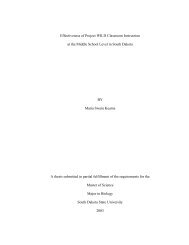
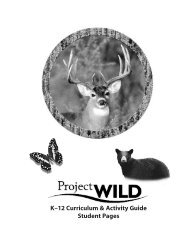
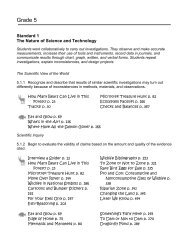
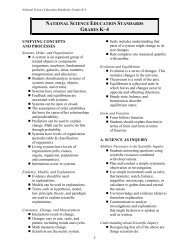
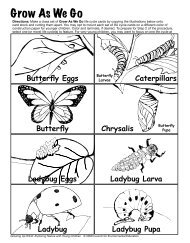
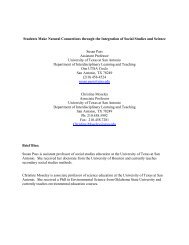
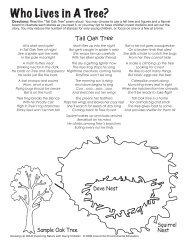
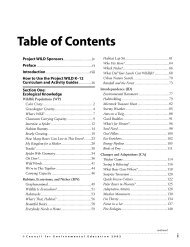
![Conceptual Framework [PDF] - Project Wild](https://img.yumpu.com/34019659/1/190x247/conceptual-framework-pdf-project-wild.jpg?quality=85)
